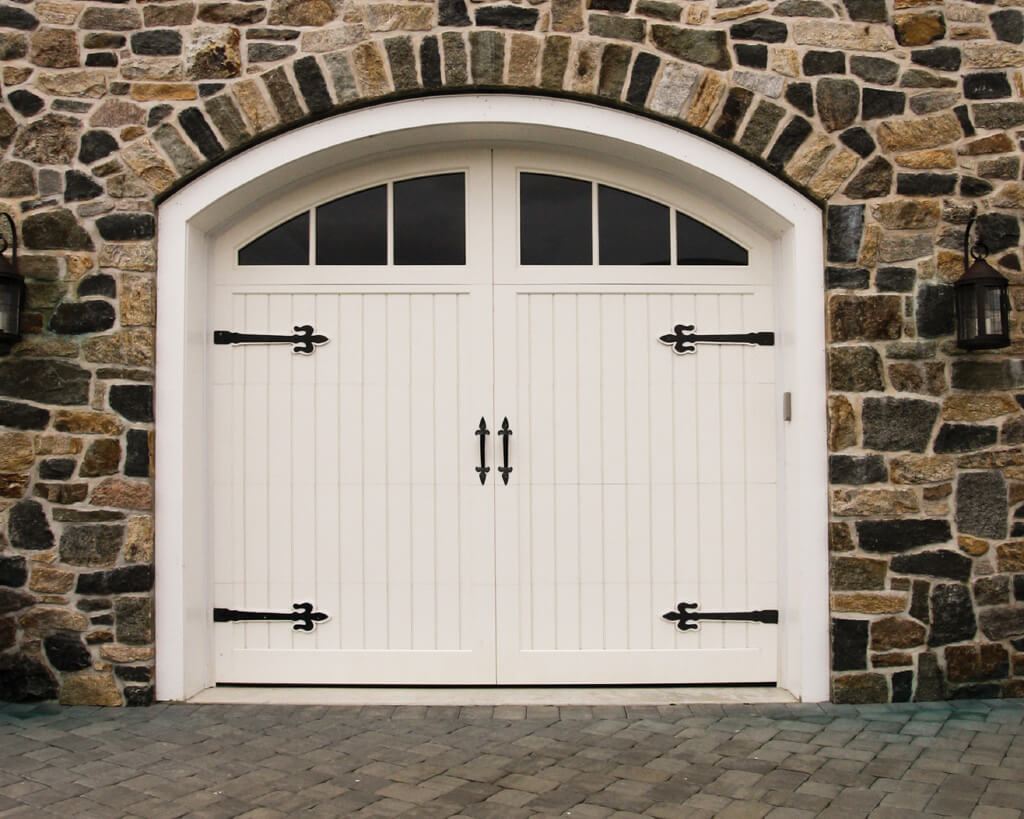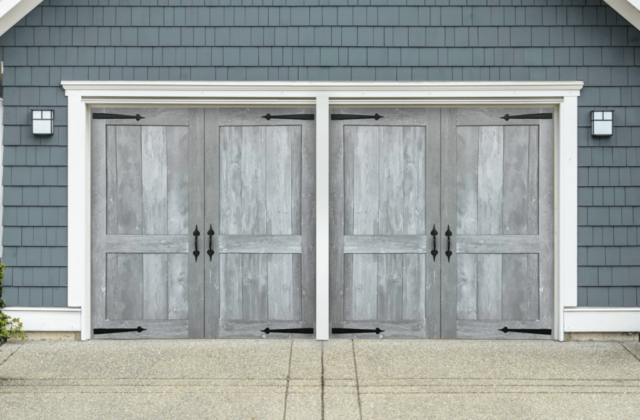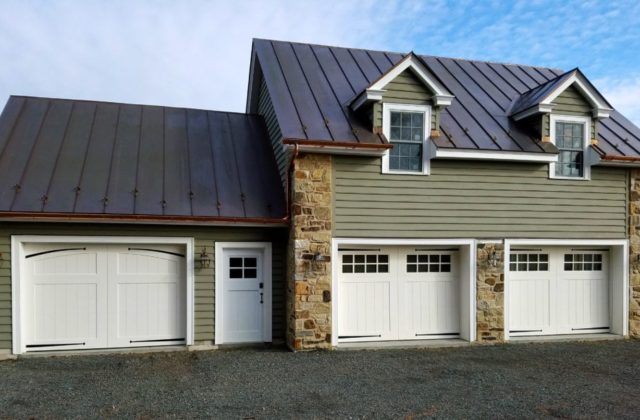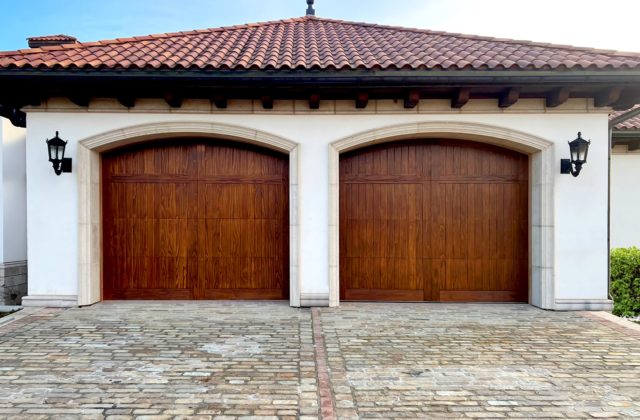If you’re in the market for a new garage door, one of the first decisions you’ll need to make is whether you want a stamped or overlay door. There are important pros and cons of each garage door type, and there’s no one-size-fits-all solution. In this blog, we’ll take a closer look at overlay vs. stamped garage doors and how they can add distinct beauty and character to your home.
What Are Carriage House-Style Garage Doors?
Stamped and overlay doors fall under the larger umbrella of carriage house (or barn-style) garage doors. These doors date back to the 1800s when families built carriage houses on their properties to store horses and buggies. Carriage house doors swung outwards to provide entry and were made from real wood that was sometimes painted or stained.
Carriage house-style doors have become increasingly popular since the 1990s and are now available in a variety of styles, materials, and finishes. They typically incorporate decorative panels and trim, accent planking, accessories, and window inserts for a unique, rustic look.
Carriage house-style doors are the perfect touch for a variety of homes, including Tudors, craftsmans, bungalows, Spanish colonials, and Victorians. However, their one-of-a-kind look can complement any home style by adding instant visual interest and curb appeal.
Stamped Steel Garage Doors
Stamped carriage house garage doors are shaped from steel and typically embossed with a wood grain finish. Essentially, the finish is “stamped” onto the face of the door. Stamped garage doors mimic the look of real wood products, making them an ideal replica of carriage house-style doors.
Because they’re made from affordable and durable steel, stamped carriage garage doors are a great option for budget-conscious homeowners. They also have a longer life expectancy than some overlay doors because steel is naturally moisture- and rust-resistant. While there are fewer design options than overlay doors, you can still choose from different window designs, colors, and finishes.
Overlay Garage Doors
Overlay garage doors have decorative panels that are placed on top of a steel, wood, or composite door. This creates a sophisticated look that’s perfect for the unique style of carriage house doors. The sky’s the limit with garage door overlays, which come in an endless number of panel styles, trim accents, window designs, paint colors, and stains.
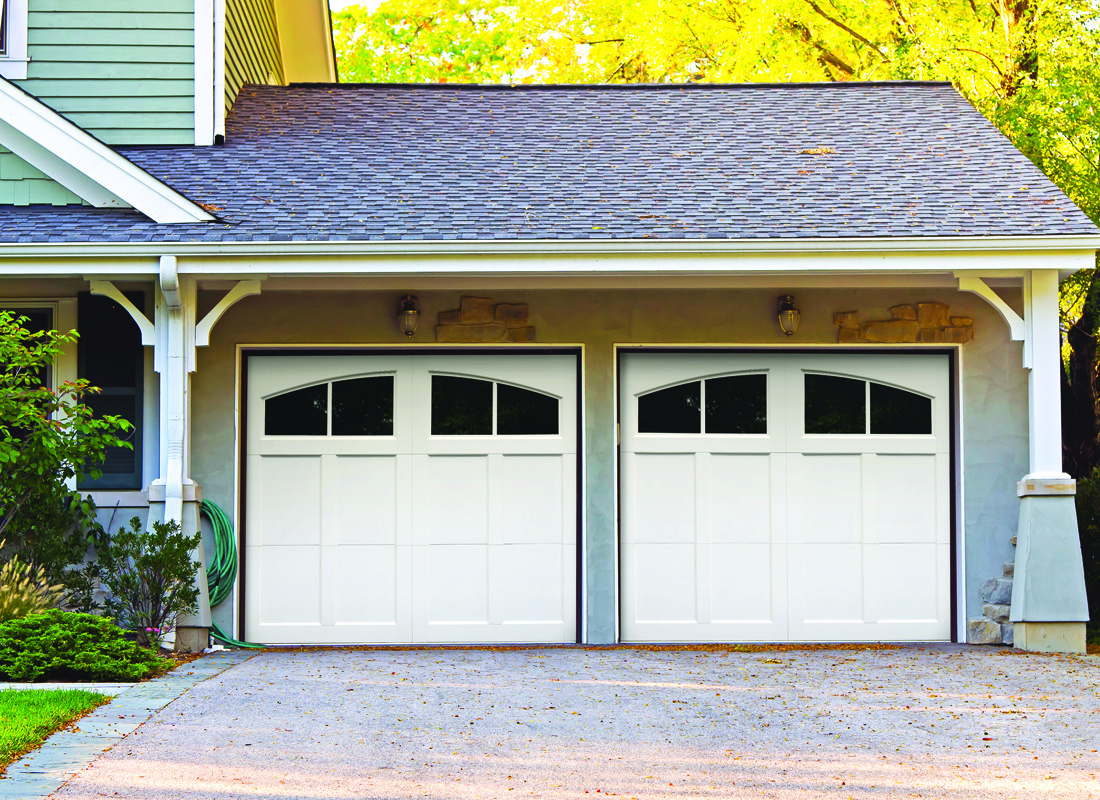
Depending on the overlay material, these doors can be more maintenance-intensive than stamped doors. They can also be more susceptible to lamination if the base and overlay expand and contract at different rates.
Carriage House Garage Door Panel Styles
Whether you select a stamped carriage house garage door or an overlay option, you’ll likely choose between two different panel styles: raised or recessed. Panels are the horizontal, vertical, or herringbone sections that make up the face of your door and can be half- or full-size. The number of panels on your garage door is determined by its style. These styles include:
- True-swing doors, which must have panels in multiples of two.
- Trifold doors, which must have panels in multiples of three.
- Bifold doors, which must have panels in multiples of four.
Raised Panels
Raised panels are created by milling the garage door and adding overlay panels. Raised panels typically have beveled edges or other details cut into their perimeter and may be surrounded by framework. They can also be stamped onto steel doors for visual appeal on a budget. You can opt for short panels placed side-by-side, or long panels that span the length of your door.
Recessed Panels
Recessed panels are sunken into the face of the garage door using overlay construction methods. They’re typically flat and are surrounded by a framework of raised decorative trim. Like raised panels, recessed options come in short or long varieties and can also be flush. Recessed panels are popular with homeowners seeking a contemporary flair for their garage door.
Materials Used in Stamped & Overlay Garage Doors
Another consideration when choosing between overlay vs. stamped garage doors is the product’s construction material. We’ll take a closer look at your main options below.
Aluminum
Aluminum is typically used as a framework for glass garage doors because it’s lightweight and rust-resistant. It’s also more malleable and ductile than steel and ideal for cold weather applications since it becomes stronger when temperatures fall. Aluminum garage door frames can be painted a variety of colors or finished with contemporary brushed detailing.
Steel
Steel is heavier and more durable than aluminum, and it’s typically the less expensive option of the two. As mentioned previously, stamped garage doors are almost always made from steel. It’s important to note that steel is subject to corrosion, so homeowners in coastal areas should be cautious when choosing these doors.
Vinyl
Also known as polyvinyl chloride (PVC), vinyl can be milled, shaped, and routed just like real wood. But unlike wood, it’s a low-maintenance material that’s insect-, salt-, moisture-, fungus-, and rot-resistant. Vinyl is also more lightweight than other materials, reducing strain on door hardware, springs, and electric openers. Vinyl garage doors are typically built on steel frames, making them incredibly durable and perfect for outdoor applications.
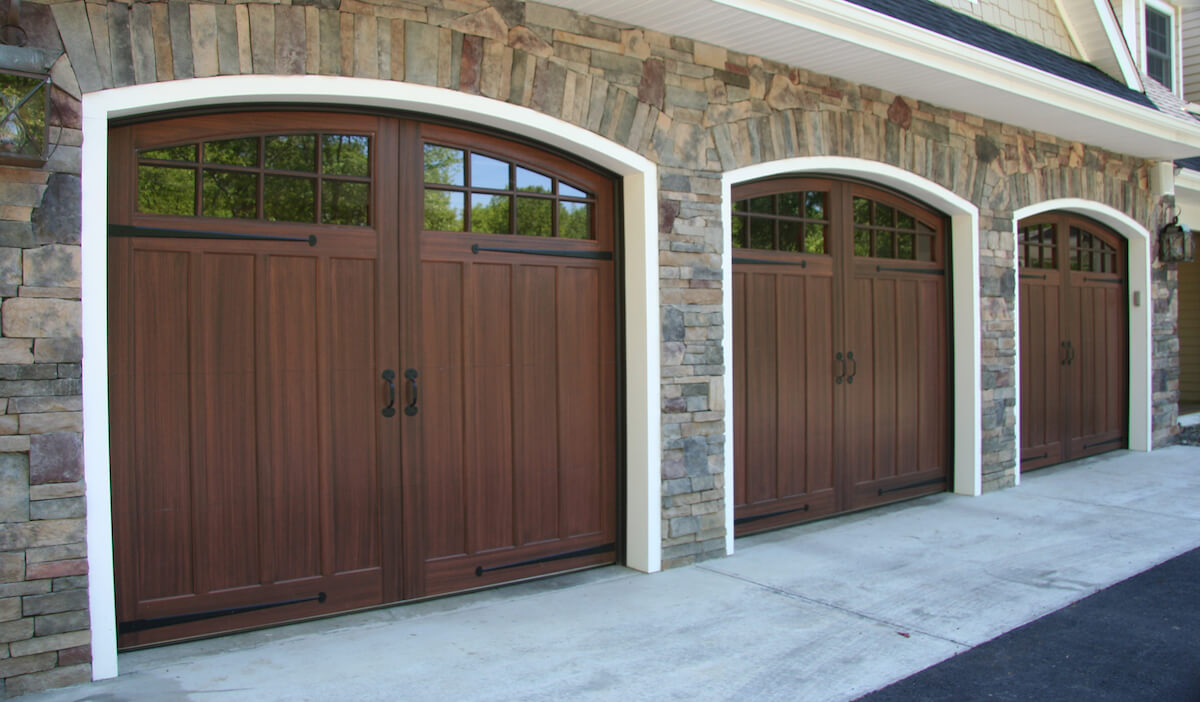
Wood
Wooden garage doors are constructed from thin layers (also known as plies) of wood and can be stained, painted, or left unfinished. You can choose from a variety of wood species, including (but not limited to) the following:
- Cedar
- Douglas Fir
- Luan
- Meranti
- Red Grandis
- Redwood
- Sapele Mahogany
- Spanish Cedar
- Western Red Cedar
While they require more maintenance than other materials, real-wood doors offer outstanding curb appeal. They’re also very effective at insulating the inside of your garage from both hot and cold weather. Depending on the species you choose and the degree of customization, a wooden garage door can be one of the most expensive options out there.
Wood Composite
Also known as wood-plastic composite (WPC), composite garage doors are made from a blend of wood fiber, plastic, and a binding agent. Wood composite may also contain fillers like bamboo, peanut hulls, and pulp fibers. Composite can be molded into any shape or size using traditional woodworking techniques and accepts paint or stain just like real wood.
Wood composite is heavy, dense, and strong, and it’s also a more low-maintenance option than real wood. Plus, it’s made from recycled and sustainable materials, making it an environmentally-friendly choice. Composite doors are also naturally moisture-, weather-, insect-, and rot-resistant for a long lifespan.
Finishes for Stamped & Overlay Garage Doors
The stamped or overlay garage door material you choose dictates whether you can paint or stain your door. We’ll take a closer look at your three main garage door finish options below.
Paint
Paint-grade doors use stain-quality woods or composites suitable only for paint finishes. As a general rule, you should use paint on wood composite, vinyl, aluminum, and urethane garage doors. Depending on your preference, you can also paint a real-wood garage door. If you paint your own door, be sure to cover all sides and edges with a high-quality, exterior-grade latex paint. Keep in mind that darker colors fade faster than lighter colors, especially in direct sunlight.
Faux Stain Paint
If you choose a wood composite garage door, you can also opt to finish it with faux stain paint. This product creates a rich finish that mimics the look of wood species like cherry, driftwood, mahogany, oak, and walnut.
Stain
Stain-grade doors use wood species that will look beautiful when stained or painted. Real-wood doors look best when stained, as it brings out the natural beauty and color of most species.
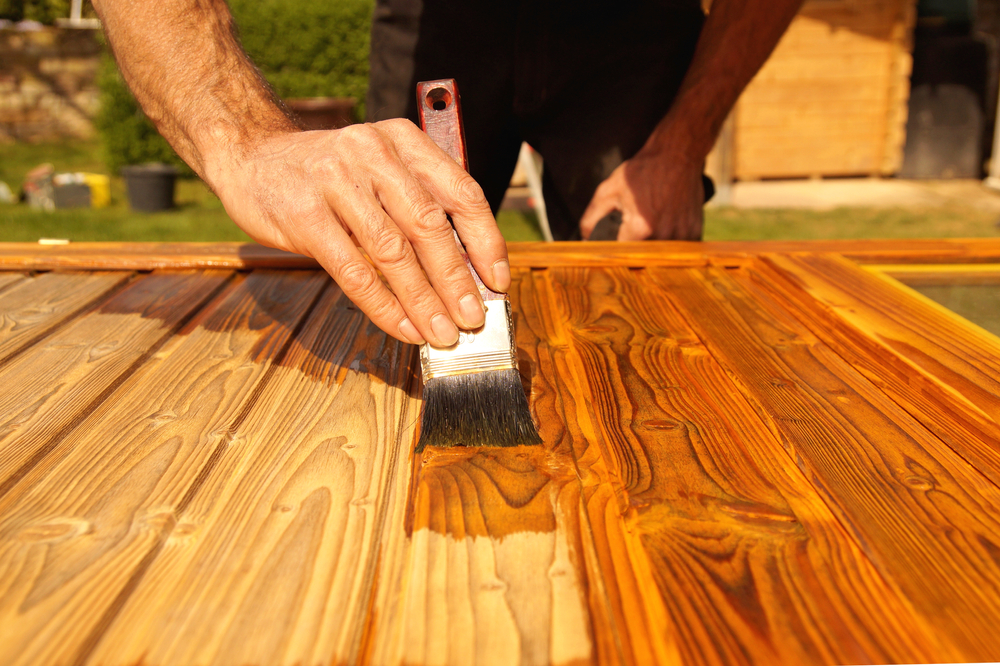
At Artisan, we use NewLook EnduraStain on all of our wooden garage doors. This five-step polyurethane wood coating system creates a durable surface barrier while retaining flexibility. You can also choose from a wide range of colors for maximum customization.
Artisan Overlay Garage Door Specifications
Interested in an Artisan overlay garage door but aren’t sure which one is right for you? You’ll find a detailed overview of how each of our overlay products is constructed below. Each numbered list moves from the side of the door facing the inside of your garage outwards. Artisan only manufactures high-quality overlay garage doors and does not offer stamped options.
Medallion (Wood)
- Mahogany luan plywood backer panel
- Urethane insulated foam core surrounded by a hem-fir frame
- Tricoya® raised or tongue and groove panels
- Frame overlay stiles and rails with profiled edges
Benchmark (Wood Composite)
- Mahogany plywood backer panel
- Urethane insulated foam core surrounded by a wooden frame
- V-groove or flat Tricoya® panels
- Extira® faux wood garage door overlay frame
Benchmark 2 (Wood Composite)
- Plywood backer panel
- Urethane insulated foam core
- Extira® facing on engineered LVL core frame
Rhapsody (Composite with Steel Frame)
- Insulated steel sandwich frame
- Polystyrene insulated foam core
- Molded composite V-groove panels
- Faux sapele mahogany molded composite facing
Quartet (Composite with Steel Frame)
- Insulated steel sandwich frame
- Urethane insulated foam core
- Faux wood grain embossed steel panels
- Molded sawn oak composite square edge overlay frame
Prelude 2 (Vinyl with Steel Frame)
- Insulated steel sandwich frame
- Polystyrene insulated foam core
- Cellular vinyl facing panels
- Vinyl laminate trim (bucks, rails, etc.)
Symphony (Vinyl with Steel Frame)
- Insulated steel sandwich frame
- Polystyrene insulated foam core
- Cellular vinyl facing panels
- Vinyl laminate trim (bucks, rails, etc.)
American Farmhouse (Urethane with Steel Frame)
- Insulated steel sandwich frame
- Urethane facing planks adhered to base sections
- Aluminum bottom retainer
Panorama (Glass with Aluminum Frame)
- Mill-finished aluminum frame surrounding tempered glass windows
